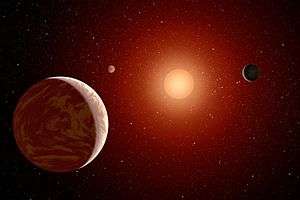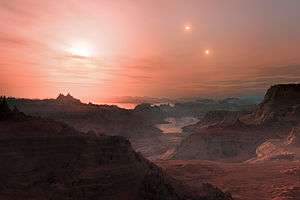Gliese 163 c
| Exoplanet | List of exoplanets | |
|---|---|---|
 | ||
| Parent star | ||
| Star | Gliese 163 | |
| Constellation | Dorado | |
| Right ascension | (α) | 04h 9m 16s |
| Declination | (δ) | 53°22' |
| Apparent magnitude | (mV) | 11.8 |
| Distance | 48.9 ly (15.0 pc) | |
| Spectral type | M3.5V | |
| Orbital elements | ||
| Semi-major axis | (a) | 0.12536 ± 0.0001 AU |
| Orbital period | (P) | 25.631 ± 0.0235 d |
| Physical characteristics | ||
| Mass | (m) | 7.3[1] M⊕ |
| Radius | (r) | 2.43 [1] R⊕ |
| Stellar flux | (F⊙) | 1.2 ⊕ |
| Temperature | (T) | 277[2] |
| Discovery information | ||
| Discovery date | September 2012 September 20, 2012 (announced) | |
| Discoverer(s) | European HARPS team led by Xavier Bonfils | |
| Discovery method | HARPS | |
| Discovery site | UJF-Grenoble/CNRS-INSU, Institut de Planétologie et d’Astrophysique of Grenoble, France. | |
| Discovery status | Announced | |
| Database references | ||
| Extrasolar Planets Encyclopaedia | data | |
| SIMBAD | data | |
| Exoplanet Archive | data | |
| Open Exoplanet Catalogue | data | |
Gliese 163 c (/ˈɡliːzə/) or Gl 163 c is said to be a potentially habitable exoplanet,[3][4] on the basis of its distance from its star being compatible with temperatures that would allow liquid water to exist on the surface, orbiting the red dwarf Gliese 163.[5] The parent star is 15.0 parsecs (approximately 49 light-years, or 465 trillion kilometers) from the Sun, in the constellation Dorado. Gliese 163 c is one of three planets discovered in the system. With a mass at least 7.2 times that of the Earth,[3][4] it is classified as a super-Earth (a planet of roughly 1 to 10 Earth masses).[4][6]
See also
References
- 1 2 PHL's Exoplanets Catalog - Planetary Habitability Laboratory @ UPR Arecibo
- ↑ "HEC: Data of Potential Habitable Worlds". University of Puerto Rico at Arecibo (Planetary Habitability Laboratory). November 12, 2012.
- 1 2 Méndez, Abel (August 29, 2012). "A Hot Potential Habitable Exoplanet around Gliese 163". University of Puerto Rico at Arecibo (Planetary Habitability Laboratory). Retrieved September 20, 2012.
- 1 2 3 Redd, Nola Taylor (September 20, 2012). "Newfound Alien Planet a Top Contender to Host Life". Space.com. Retrieved September 20, 2012.
- ↑ Staff (September 20, 2012). "LHS 188 -- High proper-motion Star". Centre de données astronomiques de Strasbourg (Strasbourg astronomical Data Center). Retrieved September 20, 2012.
- ↑ "Planet Gl 163 c". Extrasolar Planets Encyclopaedia. Retrieved 2013-03-15.
External links
| Wikimedia Commons has media related to Exoplanets. |
Coordinates: ![]() 04h 09m 16s, +53° 22′ 00″
04h 09m 16s, +53° 22′ 00″
This article is issued from Wikipedia - version of the 9/30/2016. The text is available under the Creative Commons Attribution/Share Alike but additional terms may apply for the media files.

